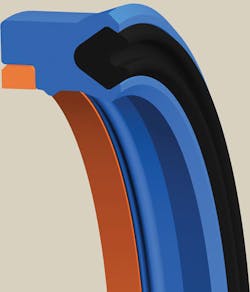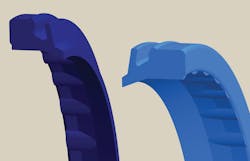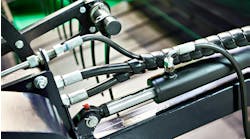Selecting the right seals for a specific heavy-duty application can be a daunting task without the expertise of a manufacturer with deep technical and engineering roots matched by field experience. Based on decades of technical knowledge and partnering with equipment manufacturers to design, test, and implement sealing solutions, the following are some of the most common piston, rod and wiper seals used in heavy-duty applications.
Challenges for Piston Seals
Piston seals are designed to prevent pressurized hydraulic fluid from leaking past a cylinder’s piston from one end of the cylinder to the other. This internal leakage wastes energy and can cause the piston to drift from a stationary position. It can also reduce extension and retraction speed and make positioning difficult.
Piston seals are selected by the amount of time, direction, pressure, and work to be done by the hydraulic cylinder. The challenge is for the seal material to maintain tight contact with the cylinder bore to prevent leakage while also resisting wear from the friction produced from the sliding motion with the bore. Common materials used for manufacturing single- and double-acting piston seals include polyurethane, rubber-fabric composite, PTFE, or polyester elastomers.
The 730 double-acting piston seal is a four-part assembly designed for use in applications where the ability to hold position without drift is important.
Piston seals are used with integrated or separate back-up rings and guide rings. Guide rings are manufactured of resin-bonded fabric and engineered plastics that steer the piston in the cylinder bore and rod in the cylinder head of a hydraulic cylinder. The guide rings prevent damage from side loading by preventing contact between metallic components.
Piston seals designed for high-pressure, high-temperature environments require materials fit for the task. Hallite’s 730 and Capped-T piston seals were designed for this purpose. The 730 double-acting piston seal is a four-part assembly designed for use in applications where the ability to hold position without drift is important, such as longwall mining roof support and large-diameter crane cylinders.
The 730 is comprised of a wear-resistant thermoplastic polyester elastomer (TPE) face seal preloaded by a profiled nitrile rubber energizer. The standard TPE face material is suitable for both roller-burnished and honed tubing.
The Capped-T double-acting piston seal uses anti-extrusion rings thicker than the industry standard to provide extra protection of the seal face and energizer from the damaging effects high-pressure shocks.
The seal also contains a pair of rectangular polyacetal anti-extrusion rings and operates at speeds to 1.0 ft/sec (0.3 m/sec), temperatures from −40° to 230°F (−40° to 110°C), and pressure to 10,000 psi (700 bar). Forces from high-pressure hydraulic pressure spikes well in excess of the system’s operating pressure can actually press a piston or rod seal into the gap between the piston or rod and the cylinder bore. Anti-extrusion rings, made of a hard material, prevent this by expanding in response to high pressure and blocking the gap.
The Capped-T double-acting piston seal uses anti-extrusion rings thicker than the industry standard to provide extra protection of the seal face and energizer from the damaging effects high-pressure shocks. The seal assembly operates at a maximum speed of 4.5 ft/sec (1.5 m/sec), in temperatures from −49° to 392°F (−45° to 200°C), and maximum pressure of 8,200 psi (600 bar). The Capped-T is manufactured with a filled PTFE cap, elastomeric energizer (usually NBR Shore 80A), and the two anti-extrusion rings.
The profile of the T621 rod seal’s NBR energizer ensures that the primary sealing lips maintain contact under low- or no-pressure conditions while ensuring proper sealing at higher pressures.
Challenges for Rod Seals
Piston-rod seals require a different design because one side seals against the ambient environment. Fluid leaking past the rod seal can reduce equipment performance and in extreme cases cause environmental issues. This means it must contain fluid within the cylinder during rod extension, retraction, and dwell periods.
The seal must also prevent contaminants from being introduced into the hydraulic system, and it must resist wear from the repeated sliding motion against the rod surface. Rod seals incorporating various combinations of PTFE and an elastomer energizer are widely used because of PTFE’s inherently low coefficient of friction and the “springiness” of elastomers to maintain a tight fit between the seal and the rod OC.
The twin-lipped 621 rod seal from Hallite use a secondary sealing lip located behind the primary sealing lip to stabilize the seal in the gland. The profile of the seal’s NBR energizer ensures that the primary sealing lips maintain contact under low- or no-pressure conditions while ensuring proper sealing at higher pressures. Made of polyurethane, the seal can perform at low and high temperatures and incorporates an acetyl anti-extrusion ring to withstand extreme pressure peaks, even with the wide extrusion gaps which result from using remote plastic bearing strips. The 621 is rated for surface speeds 3.0 ft/sec (1.0 m/sec), temperatures from −50° to 230° F (−45° to 110° C), and maximum pressure 10,000 psi (700 bar).
Hydraulic cylinders often use a buffer seal to protect the main rod seal from the effects of shock pressure loading and high-frequency pressure spikes. The buffer seal should allow adequate lubrication of the main seal and must not cause a pressure trap between itself and the main seal. Hallite’s 653 rod buffer is a single-acting seal molded of a proprietary polyurethane and lets oil pass through to the rod seal while holding back pressure spikes. It also allows pressure to pass back into the hydraulic system, thereby preventing a pressure trap between the rod seal and the buffer seal.
The 820 rod wiper (left) is available in several proprietary polyurethanes and is compatible with mineral oils and HFA (95/5) fluids used in longwall mining equipment. The 842 is a single-lipped, snap-in rod wiper developed specifically for use in environments with heavy contamination.
Wipers Provide Protection
Rod wipers are commonly used in dirty environments (especially mobile equipment) to prevent contaminants such as dirt and moisture from entering the hydraulic system as the piston rod retracts. Contamination can cause significant damage to the rod, cylinder wall, seals, and other components in the hydraulic system, and is a major cause of premature seal and component failure.
Hallite’s 820 rod wiper is available in several proprietary polyurethanes and is compatible with mineral oils and HFA (95/5) fluids used in longwall mining equipment. The 842 is a single-lipped, snap-in rod wiper developed specifically for use in environments with heavy contamination, such as agriculture, off-highway equipment, forestry, the aggregate industry, and longwall mining. Both the 820 and 842 wipers feature Umbrella Wiper Technology—a protective debris guard flap on the wiping lip that covers the gland housing and prevents the water and slurry trap often occurs with conventional wipers.
Seals for Tunnel Boring
A global trend in increased spending on development and expansion of roadways, railways, and utilities is driving demand for tunnel boring machines (TBM). The machines excavate soil, mud, rock, and any other material in their path. And these machines are huge—often up to 20 m (66 ft) in diameter, more than 100 m (328 ft) long, and weighing thousands of tons.
Hundreds of high-performance hydraulic seals contain the pressurized fluids in a TBM’s hydraulic cylinder system and keep it in motion with the highest level of protection from excavated material. Italy is host to some of the world’s largest and most complex road and rail tunnels excavated by TBMs. The need for reliable hydraulic sealing resulted in development of a custom application for an Italian OEM.
The equipment manufacturer faced the challenge of the high-pressure operation of two short-stroke crawler tensioning cylinders. One cylinder had a bore of 450 mm (17.7 in.) with an operating pressure of about 450 bar (6,500 psi). The other cylinder had a bore of 320 mm (12.6 in.) with a potential intermittent pressure to 600 bar (7,700). Adding to the challenge was a relatively large extrusion gap between the cylinder and the rod and piston.
Hallite designed rod and piston seals for both cylinders in a range of profiles and PTFE materials. Modified R16 single-acting rod seals featuring an anti-extrusion ring were included. The piston seal assembly included double-acting seals supported by special P16 single-acting piston seals on each side. P16 seals feature the same anti-extrusion ring as the R16 for effective, low-friction sealing. Tests performed in the customer’s facility confirmed that the solution was effective.
Daniele Agnesi is engineering manager for Hallite Italy. For more information, e-mail him or visit the company's website.






